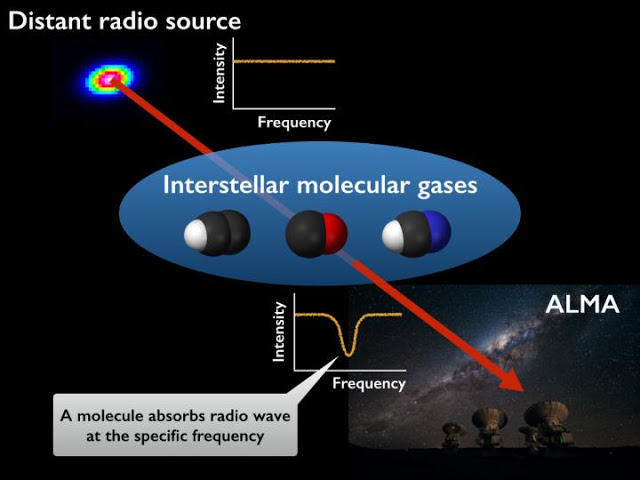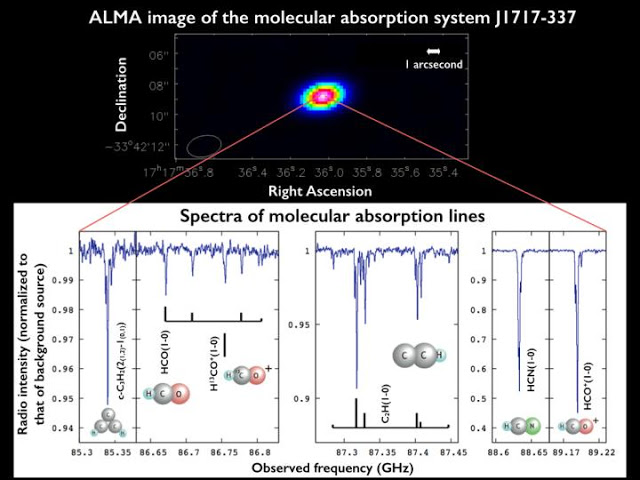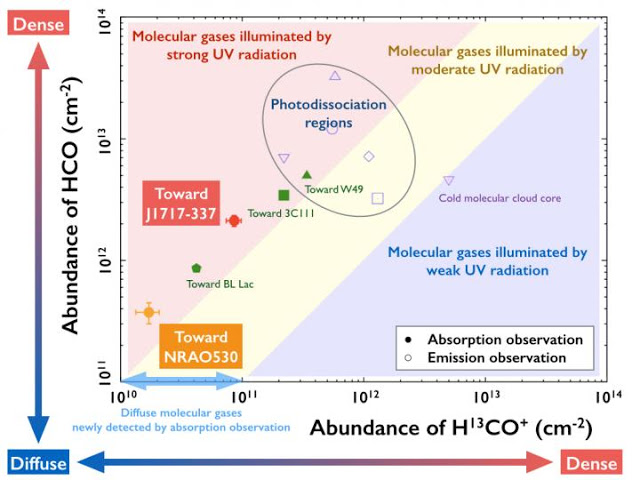| Online: | |
| Visits: | |
| Stories: |

| Story Views | |
| Now: | |
| Last Hour: | |
| Last 24 Hours: | |
| Total: | |
Radio Shadow Reveals Tenuous Cosmic Gas Cloud
Calibrator sources have flat radio spectra. Molecules in the intervening gas clouds absorb radio waves at specific frequencies determined by the type of molecules.
Credit: R. Ando (The University of Tokyo), ESO/José Francisco Salgado
To find more absorption systems, a research team including Ryo Ando (a graduate student at the University of Tokyo), Kotaro Kohno (a professor at the University of Tokyo), and Hiroshi Nagai (a project associate professor at the National Astronomical Observatory of Japan) collected the calibration data from the ALMA Data Archive.
By examining data from 36 calibrator sources, the team discovered three new absorption systems and confirmed one previously known system. For one calibrator source, J1717-337, they found absorptions caused by ten different molecules, such as C3H2, CS, and HCS+. In addition, the team found absorption signals caused by HCO molecules for two of the calibrator sources, J1717-337 and NRAO530. The HCO absorption signal is very rare; only three other examples are known in the Milky Way galaxy.
Thanks to its high sensitivity, ALMA detects many absorption lines caused by various molecules such as HCN and HCO+.
The absorption signals help us determine the environment around the foreground gas clouds. HCO molecules are thought to be formed in special environments full of intense ultraviolet light from giant young stars. The diffuse gas clouds backlit by J1717-337 and NRAO530 show chemical composition similar to the gas in active star forming regions, indicating that the diffuse gas is bathed in strong ultraviolet light. Astronomers believe that ultraviolet light affects the properties of diffuse clouds. The HCO absorption systems found by ALMA provide an opportunity to verify that idea.
The HCO absorption lines in J1717-337 (red) and NRAO530 (orange) were detected for the first time by this research. For comparison, we plot the three previously known HCO absorption systems (green), five photo-dissociation regions (blue), and a cold molecular cloud core (purple). The abundances are shown in column density, which indicates the number of molecules integrated along the line of sight towards a source. The ratio of HCO to H13CO+ indicates the strength of the ultraviolet light.
Credit: R. Ando (The University of Tokyo)
Contacts and sources:
The University of Tokyo
National Astronomical Observatory of Japan.
This observation result was published as Ando et al. ‘New detections of Galactic molecular absorption systems toward ALMA calibrator sources’ in the Publications of the Astronomical Society of Japan, issued in December 2015.
Source: http://www.ineffableisland.com/2015/12/radio-shadow-reveals-tenuous-cosmic-gas.html





